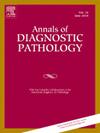Impact of surgical technique on histopathological specimen quality: Transurethral resection of the prostate versus bipolar enucleation of the prostate
IF 1.4
4区 医学
Q3 PATHOLOGY
引用次数: 0
Abstract
This study examines the effects of Transurethral Resection of the Prostate (TURP) and Bipolar Enucleation of the Prostate (BipoLEP) techniques on the histopathological quality of specimens in benign prostatic hyperplasia surgery. A retrospective analysis was conducted on 200 patients (100 TURP, 100 BipoLEP) treated at a single center between January 2021 and January 2023. Specimens were systematically evaluated for artifacts, including fragmentation, thermal, telescoping, sectioning, processing, and staining artifacts. The relationship between surgical technique and artifact types was analyzed using independent samples t-tests, while pathological diagnoses were compared using the chi-square test. Additionally, a pilot group of 10 patients (5 TURP, 5 BipoLEP) underwent immunohistochemical analysis with p63, p27, and androgen receptor to assess antigen preservation. Fragmentation was significantly higher in the BipoLEP group (87 %) compared to the TURP group (6 %) (p < 0.001). Conversely, thermal artifacts were notably more frequent in TURP specimens (97 %) than in BipoLEP (22 %) (p < 0.001). Sectioning artifacts were observed more often after TURP (24 %) compared to BipoLEP (4 %) (p < 0.001), while telescoping artifacts were also more prevalent in BipoLEP (90 %). No significant differences were detected between groups regarding processing or staining artifacts. Both techniques provided comparable diagnostic adequacy and rates of incidental prostate cancer detection. In conclusion, the choice of surgical technique substantially influences the type and frequency of histological artifacts. Therefore, awareness of the surgical method is vital for pathologists to ensure accurate interpretation and optimal patient management.
手术技术对组织病理学标本质量的影响:经尿道前列腺切除术与双极前列腺切除术。
本研究探讨了经尿道前列腺切除术(TURP)和双极前列腺摘除(BipoLEP)技术对良性前列腺增生手术标本组织病理学质量的影响。回顾性分析了在2021年1月至2023年1月期间在单一中心接受治疗的200例患者(100例TURP, 100例BipoLEP)。系统地评估标本的人工制品,包括破碎,热,伸缩,切片,处理和染色人工制品。手术技术与伪影类型的关系采用独立样本t检验进行分析,病理诊断采用卡方检验进行比较。此外,一组10例患者(5例TURP, 5例BipoLEP)接受p63, p27和雄激素受体的免疫组织化学分析,以评估抗原保存情况。BipoLEP组骨折发生率(87%)明显高于TURP组(6%)
本文章由计算机程序翻译,如有差异,请以英文原文为准。
求助全文
约1分钟内获得全文
求助全文
来源期刊
CiteScore
3.90
自引率
5.00%
发文量
149
审稿时长
26 days
期刊介绍:
A peer-reviewed journal devoted to the publication of articles dealing with traditional morphologic studies using standard diagnostic techniques and stressing clinicopathological correlations and scientific observation of relevance to the daily practice of pathology. Special features include pathologic-radiologic correlations and pathologic-cytologic correlations.

 求助内容:
求助内容: 应助结果提醒方式:
应助结果提醒方式:


